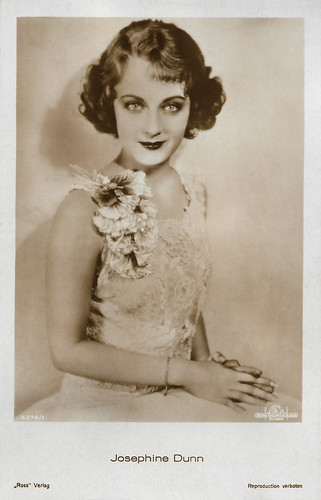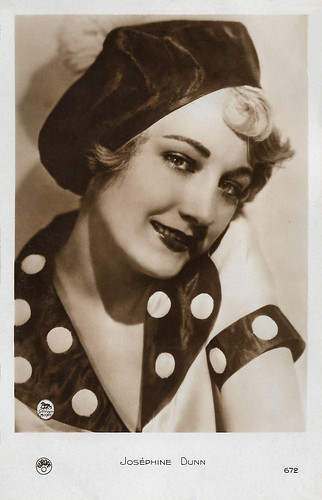
Dutch postcard by J.S.A. (J. Sleding, Amsterdam, no. 128. Photo: Ruth Harriet Louise, 1929 / Metro-Goldwyn-Mayer.

Italian postcard by Edizioni Aperol, Padova. Photo: Ruth Harriet Louise / Metro Goldwyn Mayer.

German postcard by Ross Verlag, no. 3788/1, 1928-1929. Photo: Metro-Goldwyn-Mayer. Josephine Dunn in Excess Baggage (James Cruze, 1928).
A ravishing blue-eyed blonde
Mary Josephine Dunn was born in New York City, in 1906. She grew up in her native New York and attended Holy Cross Convent, a Catholic girls' school there. At the age of 14, she became a chorus girl at the Winter Garden Theatre in 'Good Morning, Dearie'. After her first successes, Dunn dropped out of school and from then on devoted herself exclusively to the theatre.
She was briefly in the Ziegfeld Follies and, in 1924, had a walk-on in 'Dear Sir' on Broadway. Two years later, she was picked by a talent scout to join the Paramount acting school for hopeful young debutantes. She began her Hollywood career with a small role alongside Thelma Todd in Fascinating Youth (Sam Wood, 1926).
She graduated from the Paramount Pictures School, which was set up by Paramount Pictures for their young actors without a high school diploma. A ravishing blue-eyed blonde, she made an impression in D.W. Griffith's The Sorrows of Satan (1926). In 1927 Dunn got her first leading role opposite Evelyn Brent in Love's Greatest Mistake (A. Edward Sutherland, 1927).
In 1927, she played the female lead alongside Al Jolson in the Warner Brothers-produced The Singing Fool (1927), a sequel to the hugely successful The Jazz Singer of the same year, but which failed to match the success of its predecessor. After another leading role opposite Wallace Beery in Fireman, Save My Child (A. Edward Sutherland, 1927), she took a nine-month break.
Then she joined Metro-Goldwyn-Mayer and acted in Our Modern Maidens (Jack Conway, 1929) with Joan Crawford and Anita Page. She married Clyde Greathouse during the mid-1920s, divorcing him shortly thereafter. In 1925 she married William P. Cameron, whom she also divorced in 1928. She would star in a total of twenty-three silent films, and in 1929 she was one of thirteen WAMPAS Baby Stars, which that year also included actress Jean Arthur.

German postcard by Ross Verlag, no. 4274/1, 1929-1930. Photo: Metro Goldwyn Mayer.

Austrian postcard by Iris-Verlag, no. 5592. Photo: Paramount.
Playing vamps and mercenary wives
In 1930 Josephine Dunn made a successful transition, unlike many silent stars, to sound films. She starred in Safety in Numbers (Victor Schertzinger, 1930) alongside Charles 'Buddy' Rogers and Kathryn Crawford.
She had good reviews in the Ernst Lubitsch-directed operetta One Hour with You (1932) as Mademoiselle Martel. She starred in sixteen films through 1932, and at the peak of her career in 1933 she played vamps and mercenary wives.
That same year, she married Eugene J. Lewis, whom she divorced in 1935 to marry Carroll Case, whose father Frank Case owned the Algonquin Hotel in New York City, which housed the now-famous Algonquin Round Table. In the 1920s, Dunn had already become associated with the Algonquin Round Table, a meeting place for a group of actors, critics, wits, and writers, between 1919 and 1929.
Dunn retired from acting in 1938 and remained with Case for the remainder of his life. She made sporadic appearances in summer stock during the 1940s.
Her husband died in 1978 and Josephine Dunn died 6 years later in 1983, in Thousand Oaks, California, aged 76. The actress was buried alongside her husband in a columbarium at Westwood Village Memorial Park Cemetery.

French postcard by Cinémagazine-Edition, Paris, no. 670. Photo: Ruth Harriet Louise / Metro-Goldwyn-Mayer.

French postcard by Europe, no. 672. Photo: Ruth Harriet Louise, 1929 / Metro-Goldwyn-Mayer.

German postcard by Ross Verlag, no. 4904/1, 1929-1930. Photo: Ruth Harriet Louise / Metro-Goldwyn-Mayer.
Sources: I.S.Mowis (IMDb), Wikipedia and IMDb.
No comments:
Post a Comment